The 10 Best Luxury Cars of 2022
The 10 Best Luxury Cars of 2022
Introduction to Luxury Vehicles
Luxury vehicles represent a distinct segment of the automotive market, characterized by their superior quality, exceptional performance, and advanced technology. A vehicle is generally considered luxury when it offers features that elevate the driving experience beyond the ordinary. This includes meticulously crafted interiors, high-grade materials, and cutting-edge technological innovations that enhance both comfort and convenience. Furthermore, the performance of luxury cars often surpasses that of standard models, providing drivers with a dynamic and responsive experience on the road.
Comfort is another defining attribute of luxury vehicles. Manufacturers focus on creating plush seating, advanced climate control systems, and refined acoustics, ensuring an enjoyable ride for all passengers. Moreover, luxury cars often come equipped with comprehensive infotainment systems that integrate seamlessly with digital devices, further enriching the driving experience with connectivity and entertainment options.
Branding also plays a pivotal role in the luxury car segment. Consumers often associate specific names with prestige, heritage, and excellence, establishing an emotional connection to the brands they choose. This perception is further enhanced by the exclusive nature of luxury vehicles, which often come with bespoke options and limited availability, making ownership a statement of status.
In recent years, sustainability has emerged as a significant consideration within the luxury car market. Consumers are increasingly conscious of environmental impact, prompting luxury manufacturers to innovate. Electric and hybrid models are being developed, offering performance without compromising eco-friendliness. Ultimately, the blend of quality, performance, technology, comfort, and a commitment to sustainability underscores the appeal of luxury vehicles, distinguishing them in an ever-competitive automotive landscape. As we delve into the top models of 2022, understanding these facets will provide crucial context for evaluating what makes these vehicles exceptional.
Top 10 Luxury Cars of 2022
In 2022, the luxury automobile market witnessed remarkable innovations in design, technology, and performance. The following list highlights the ten best luxury cars of the year, noting their distinguishing features, specifications, and price ranges.
1. Mercedes-Benz S-Class – Renowned for its plush interiors and cutting-edge technology, the S-Class features a 3.0L inline-six engine producing 429 horsepower. Priced starting around $110,000, it offers an unparalleled driving experience with advanced safety features.
2. BMW 7 Series – This executive sedan combines performance with luxury. Its powerful 4.4L V8 allows an impressive 0-60 mph time of 3.9 seconds. Starting at roughly $86,000, the 7 Series highlights a sumptuous interior equipped with the latest tech.
3. Audi A8 – The A8 stands out with its elegant design and intelligent technology integration. Its 3.0L V6 engine delivers 335 horsepower, and the starting price is approximately $86,500, making it a compelling choice for luxury buyers.
4. Lexus LS – This flagship luxury sedan offers a hybrid option that combines power with fuel efficiency. Its 3.5L V6 hybrid engine produces 354 horsepower and starts at around $76,000. The LS is known for its reliability and comfort.
5. Porsche Panamera – Offering a blend of sporty dynamics and luxury, the Panamera features various engine options, including a V8 producing 620 horsepower. Starting at $87,000, it is recognized for its outstanding performance and handling.
6. Tesla Model S – The all-electric Model S sets the standard for performance EVs, claiming a 0-60 mph in just 1.99 seconds. With prices beginning at $99,990, it boasts advanced tech and autopilot features.
7. Rolls-Royce Ghost – Representing the pinnacle of luxury, the Ghost features a twin-turbo V12 engine with 563 horsepower. Starting around $332,500, its bespoke craftsmanship and opulence are unmatched.
8. Bentley Continental GT – This grand tourer combines luxury with performance. With a 4.0L twin-turbo V8 engine that produces 542 horsepower, starting at $202,500, it’s perfect for those seeking elegance and thrill.
9. Maserati Quattroporte – The elegant Quattroporte features an Italian design, offering a 3.0L twin-turbo V6 engine with 424 horsepower. Priced from $104,000, it’s known for its exclusivity and driving pleasure.
10. Ferrari Roma – This entry-level Ferrari merges luxury with sports car performance. Its 3.9L twin-turbo V8 engine develops 612 horsepower. With a starting price of about $222,620, it offers an exhilarating driving experience paired with unparalleled style.
Each of these luxury vehicles showcases unique attributes that cater to discerning buyers, encapsulating the best of automotive excellence in 2022.
Innovations and Trends in Luxury Cars
As 2022 unfolds, the luxury automobile market is marked by significant innovations that reflect both technological advancements and changing consumer preferences. A prominent trend is the shift towards electric and hybrid vehicles, driven by heightened environmental awareness and government regulations. Luxury car manufacturers are increasingly investing in electric vehicles (EVs) to meet the demand for greener options without compromising on performance or comfort. These models boast impressive ranges, rapid charging capabilities, and exceptional acceleration, making them a desirable choice for affluent consumers.
Alongside the rise of electric powertrains, the integration of advanced smart technology is revolutionizing the luxury driving experience. Infotainment systems are becoming more sophisticated, featuring touchscreen interfaces coupled with voice recognition that allow for seamless interaction with multimedia, navigation, and vehicle functions. Furthermore, luxury brands are enhancing in-car connectivity, enabling drivers to access a range of apps and services from their smartphones. This trend is indicative of a broader consumer expectation for always-connected experiences.
Another key focus in the luxury segment is the push for autonomous driving features. Manufacturers are heavily investing in technologies that support semi-autonomous and fully autonomous driving capabilities. This is not only aimed at improving safety and convenience but also at aligning with the futuristic vision of personal transportation. Though complete autonomy remains a goal for many, advancements in driver assistance systems are showcasing the luxury market’s commitment to leading-edge technology.
Sustainable manufacturing practices are also gaining traction among luxury car manufacturers. By adopting eco-friendly materials and emissions-reducing production methods, companies are striving to align themselves with a more conscientious consumer base. These initiatives are reflective of a shift toward sustainability within the industry, as luxury brands aim to balance opulence with environmental responsibility.
Conclusion: Choosing the Right Luxury Car
In selecting a luxury car, it is imperative to recognize that personal preferences play a fundamental role. Each driver has unique needs and values, ranging from the desire for performance to the emphasis on comfort or advanced technology. Therefore, evaluating the ten luxury vehicles presented provides a comprehensive overview, yet the ultimate decision must resonate deeply with individual lifestyle and priorities.
Budget is often a pivotal factor in the car-buying process. Spending on a luxury car entails more than the initial purchase price; potential buyers should also account for ongoing costs such as insurance, fuel, and maintenance. It is prudent to establish a clear financial plan before diving into the luxury car market. Additionally, fuel efficiency has become a significant concern for many buyers, especially in an era where sustainability is increasingly valued. Understanding the fuel consumption of prospective vehicles and comparing them against personal usage patterns can greatly influence long-term ownership costs.
Maintenance and resale value are also crucial considerations to be mindful of when choosing a luxury car. Some brands are notorious for high service costs, while others may boast better resale values due to demand and reputation. Researching these aspects can provide insights into the total cost of ownership over time. Moreover, potential buyers are encouraged to thoroughly engage in the test-driving process. Experience behind the wheel allows one to better gauge comfort, handling, and personal connectivity with the vehicle, elements that can never be truly assessed through numbers alone.
Ultimately, the journey to finding the ideal luxury vehicle should be guided by informed decision-making, taking into account all factors—financial, practical, and emotional. As you explore your options, remember that the perfect luxury car is not only about brand prestige but should also align harmoniously with your life’s aspirations.
1. BMW i7
9
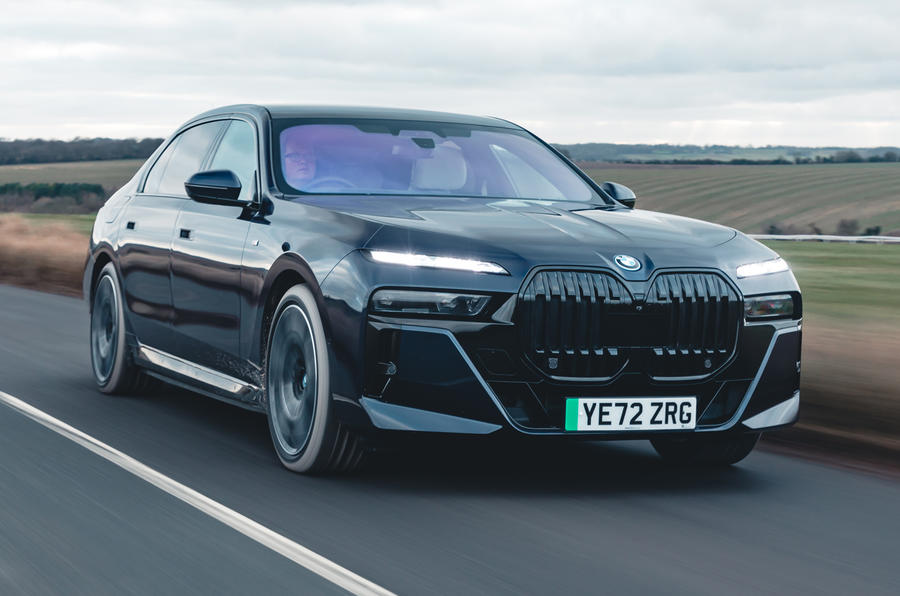
If you need proof of how serious BMW is about staking its claim on luxury car glory, then consider the fact the i7 (and its ICE-powered 7 Series sibling) will only be available in leg-stretching long-wheelbase guise.
While the previous six generations of the brand’s flagship saloons have placed as much emphasis on driver delight and pampering passengers, this all-new model is all about five-star cosseting and cutting-edge tech.
It’s the all-electric i7 that arrives first, but regardless of motive power, you’re unlikely to lose the big BMW in a crowd. Not only is it a vast machine, but the slab-sided styling and gargantuan front grille also mean that the 7 Series is a ‘challenging’ aesthetic proposition.
Not so the interior, which melds all the latest technology with traditional craftsmanship and a rich array of natural materials, including the surprisingly indulgent cashmere wool trim you can choose for the seats.
As you’d expect, there’s acres of space to lounge around in, while additions such as the 31.3in BMW Theatre Screen for rear-seat passengers takes in-car entertainment to the next level.
There’s also the usual widescreen display ahead of the driver, but the retention of an iDrive rotary controller means you’re not subjugated to the total tyranny of a touchscreen interface.
Using a twin-motor set-up and a 102kWh battery, the i7 is good for 536bhp, a claimed range of 367 miles and 0-62mph in 4.7sec. Less impressive is a kerb weight just shy of 2800kg.
However, while performance is strong and the 7 Series handles with the polish and precision you expect (there’s four-wheel steering for improved agility), it’s the new-found sense of comfort that really sets the i7 apart from its predecessors, the supple and controlled ride easily matching the best efforts of the Range Rover and Mercedes S-Class. Factor in hushed refinement and the latest 7 Series finally delivers the luxury goods its forebears never quite managed to nail.
Later this year the i7 will be joined by a pair of plug-in hybrids, but until then the i7 remains a deeply impressive addition to the upper-class saloon firmament.
Read our BMW i7 review
Munich brand’s flagship returns to take on the Mercedes-Benz S-Class, this time in petrol PHEV format
2. Mercedes-Benz S-Class
9
BMW may have knocked it out of the park with the latest 7 Series, but the Mercedes-Benz S-Class is still the default option for good reason. It was last redesigned in 2020, embracing digitisation more than ever before.
In that respect, it has undoubtedly succeeded. The cabin feels reassuringly traditional yet avant garde, and the scope of the vast displays manages to avoid the jarring omnipresence seen with other manufacturers’ cars.
Ambient lighting and connectivity are very well executed, and beneath it all, barring one or two ergonomic shortfalls, resides one of the most materially comfortable and cosseting places to sit while the miles ease by, for driver and passenger. In an age of ever more ludicrously grandiose grilles, the S-Class’s relatively subtle exterior design should also stand it in good stead in Europe.
If you want your big Merc with a big battery pack instead of an engine, you need to look towards the Mercedes EQS, which is an entirely fresh take on the electric luxury car and shares next to nothing with its more traditional counterpart, unlike the BMW 7 series and i7 twins.
There’s very little wrong with the S-Class’s range of petrol, diesel and hybrid powertrains, though. The line-up tends to shift with availability, but you usually get a choice between the S350d or S400d diesel, or an S500 petrol, which also gets mild-hybrid assistance.
The diesels are pleasingly real-world frugal and smooth, and the S400d has all the performance that a car of this brief would ever need, but the S500 offers an even quicker (and yet still suitable quiet and smooth) 400bhp-plus option should you want it. There’s also the plug-in petrol-electric S580e with a combined might of 503bhp, the ability to travel up to 64 miles in electric-only mode and a more manageable company car tax bill than the combustion-only models.
In some ways, though, it feels as though progress has stalled somewhat. The plug-in hybrid powertrain of our S580e sets new class standards for efficiency and versatility, but cabin isolation and ride quality seem no better than before. Where an S-Class used to challenge Rolls-Royce in terms of road manners, the British marque is now a clear step ahead. The new S-Class is a fantastically opulent way to travel, but no longer is it breathtakingly so.
Read our Mercedes-Benz S-Class review
3. BMW iX
9
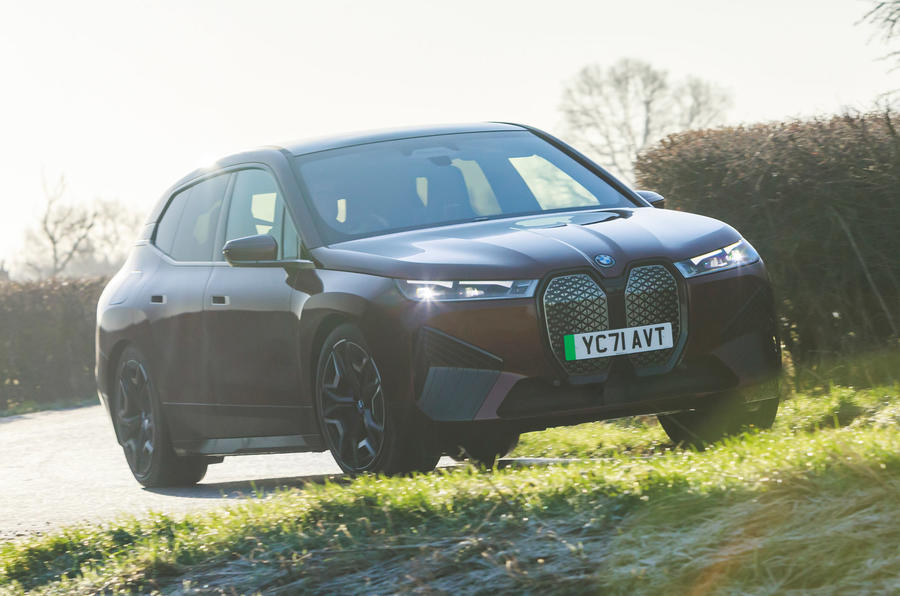
Number three on this list is a double whammy of convention defiance. Not only is the BMW iX not a saloon, but it also doesn’t have a combustion engine. It came just over a year before the BMW i7, but it is effectively that car, a few inches higher up in the air. It’s perhaps marginally less opulent, but having a hatchback, it’s also a bit more practical.
“A BMW like no other” is how our man Greg Kable described the iX, the firm’s new all-electric luxury SUV flagship model for its ‘i’ brand. Some critics have used other words to make their feelings plain about the way this car looks and the departure from classic BMW design type that it, and other recent BMW model debutants, represent. Feel free to make up your own mind: this is a car clearly intended to provoke a reaction.
There is an entry-level BMW iX xDrive40 version, which gets 296bhp and 249 miles of WLTP-certified electric range. But really, you want the xDrive50, with its plusher air suspension and 373 miles of range, which truly makes this a viable long-distance luxury car. If you need to charge en route, it takes up to 200kW. The BMW iX xDriveM60 offers even more power and performance than the xDrive50’s 516bhp, but we remain unconvinced that anyone needs their internal organs rearranged any more violently than the mid-range model is already capable of.
The BMW iX saw off the Mercedes-Benz EQS in a comparison test. The Mercedes is comfortable, but the isolation and sophistication of the iX’s ride is really very special indeed and makes it a particularly compelling luxury car. The BMW also counters the EQS’s wide-eyed futurism with a warmer, more idiosyncratic and less formal flavour, both inside and out.
The iX continued to impress when we put it through our full road test. The car’s combination of generous SUV-level cabin comfort and versatility, and of a genuinely relaxing and understated luxury ambience, with world-class rolling refinement and drivability, instant and effortless performance, and creditable real-world range is unmatched by any of the market’s other zero-emission SUVs. Even if it doesn’t smash down barriers in terms of outright electric range in the way that some will expect of a top-level EV, the BMW iX has compelling fitness for purpose and a real completeness of appeal as a near-£100,000 luxury car.
Read our BMW iX review
4. Range Rover
9
The latest, fifth generation is a very long way from the mildly gentrified farm truck that was the original Range Rover. It is now a fully fledged luxury car, one that trades some of the other entries’ on-road dynamics for unbelievable off-road ability.
Under the skin, it’s all-new, featuring Land Rovers MLA-Flex architecture, which has an 80% aluminium construction for lightness and strength (torsional rigidity is up 50% over the old car). In combination with finely honed air suspension, 48V active anti-roll bars and the availability of four-wheel steering, this Range Rover handles with assured precision and surprising agility. It’s also whisper-quiet on the move and has a sumptuous ride that steamrollers awkward topography into submission. Some of the other cars on this list are even more refined, though. Especially on big wheels, a bit of thumping and the odd shimmy from the body can disturb the serenity slightly.
Its maker’s lately added straight-six diesel engines are carried over from the old model and, with mild-hybrid assistance, offer all the urge you will need and emit only a faint murmur even when extended. For fleet operators looking to keep their CEOs happy, the plug-in hybrid Range Rover P440e and Range Rover P510e models offer up to 70 miles of electric-only range, which makes for 5% company car tax. Plutocrats more interested in performance than the fate of the planet can opt for a 523bhp 4.4-litre petrol V8 (taken from BMW). The Range Rover P530 will allow them to crack 62mph from standstill in a claimed 4.4sec. An EV version is on the way as well.
Whichever model you choose, you will benefit from the same interior that effortlessly melds traditional club-class quality and comfort with all the latest tech. There’s also more than enough space to lounge around, although that hasn’t stopped Land Rover from offering an extended-wheelbase version too.
Ultimately, whatever you need and want from a luxury car, the brilliantly executed Range Rover has it covered. The price of entry these days has risen to just shy of £100,000, which is rather a lot, but it’s a mark of the car’s abilities that it easily justifies this figure – and more besides.
Read our Range Rover review
5. Mercedes-Benz EQS
8
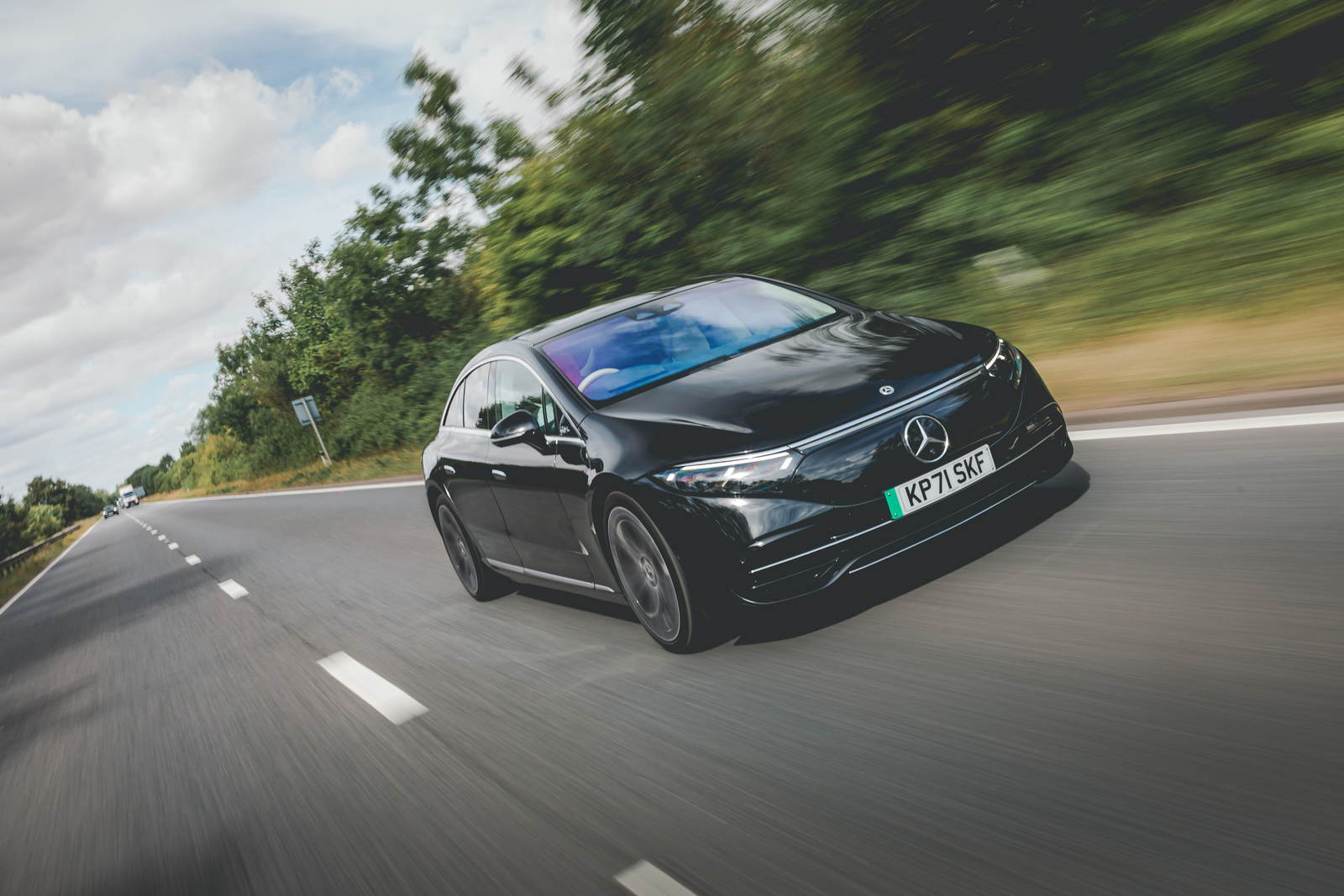
Mercedes-Benz is taking a rather different approach to its flagship EV saloon from its BMW rival. Where the BMW 7 Series and BMW i7 share a platform, the S-Class and the EQS are entirely different cars.
The quiet running of an EV undoubtedly suits a luxury car, and the EQS is quite the engineering achievement. With a drag coefficient of 0.20 it uses the lack of air vents to good effect, and in combination with a massive 120kWh battery, that helps it to achieve a real-world range of close to 400 miles in Mercedes EQS 450+ guise.
It’s roomy and quiet and it rides reasonably well, too. However, some of the materials in the interior aren’t up to the standards you would expect of a car that starts from over £105,000. The EQSs we’ve driven in the UK have also come on very big wheels and they couldn’t quite match the best-riding cars here.
Read our Mercedes-Benz EQS review
6. Audi A8
8
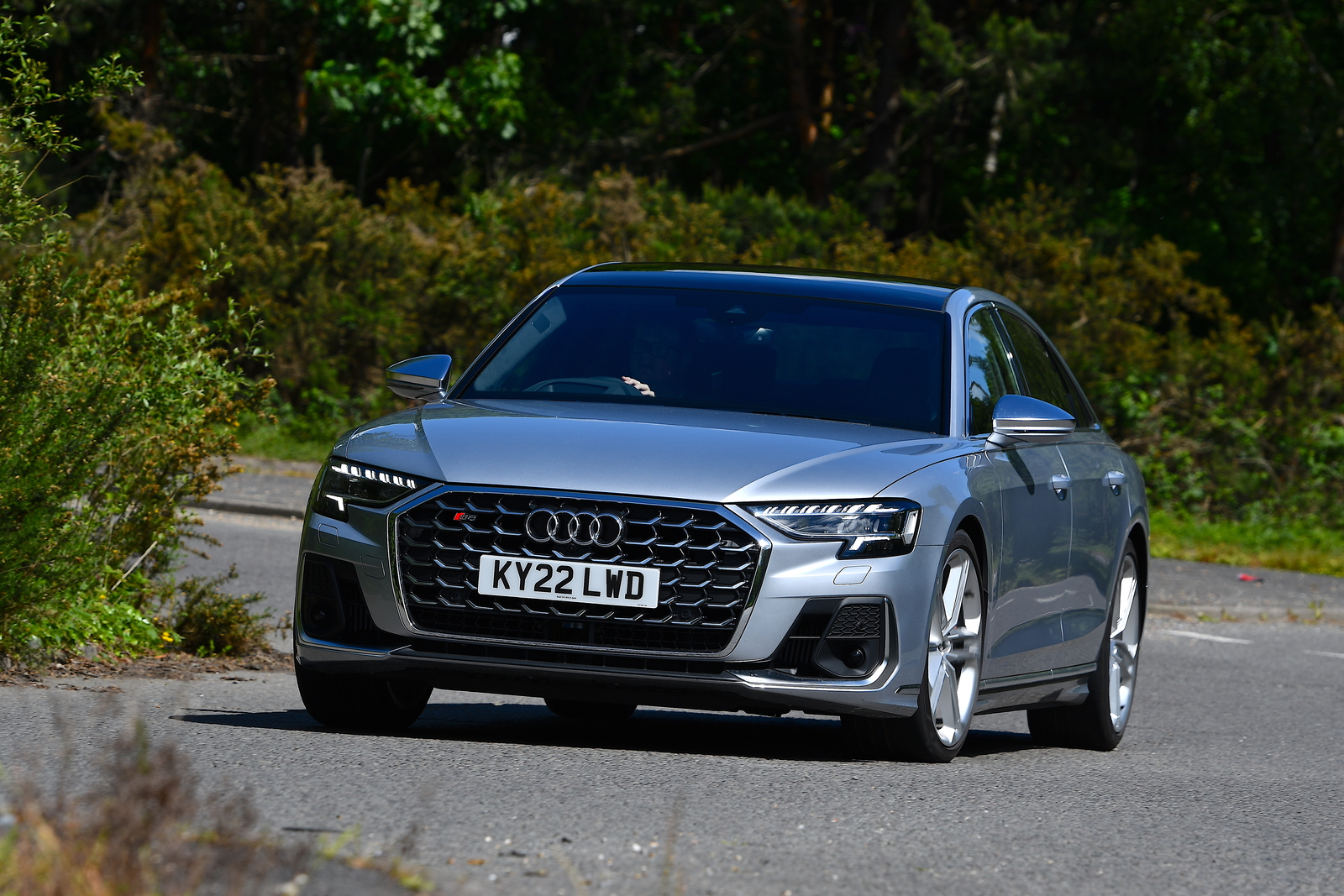
The Audi A8 is one of the older cars on this list. The current generation was always a bit behind its peers for refinement, and although the A8’s quality interior feels like it was built to outlast civilisation itself, it lacks the sense of occasion of the latest BMW 7 Series or Range Rover.
However, a facelift in 2022 has allowed Audi to throw a box of technology at its flagship limousine. While all A8s have adaptive air suspension, the sportier, V8-powered S8 features what Audi calls Predictive Active Suspension, which mixes forward-facing cameras with a height-adjustable air suspension set-up that incorporates fast-acting electromechanical actuators at each wheel.
Although manufacturers such as DS and Genesis tout similar-sounding systems, this one really works thanks to air springs and 48V active anti-roll bars. Bumps and sleeping policemen pass by uncannily smoothly. Noise and vibration isolation aren’t quite perfect, and the suspension can’t smother shorter, sharper inputs as effectively as bigger ones. However, this car represents Audi doing classic Vorsprung Durch Technik in a properly committed way.
There’s a choice of turbocharged engines – a 282bhp diesel or 335bhp petrol – with four-wheel drive as standard and a 48V electrical system that gives it mild-hybrid capability. Higher up the model range, you will find the tax-saving six-cylinder petrol Audi A8 60 TFSIe, whose refinement and effortless responsiveness really boost the appeal of the car’s driving experience.
Read our Audi A8 review
7. Range Rover Sport
8
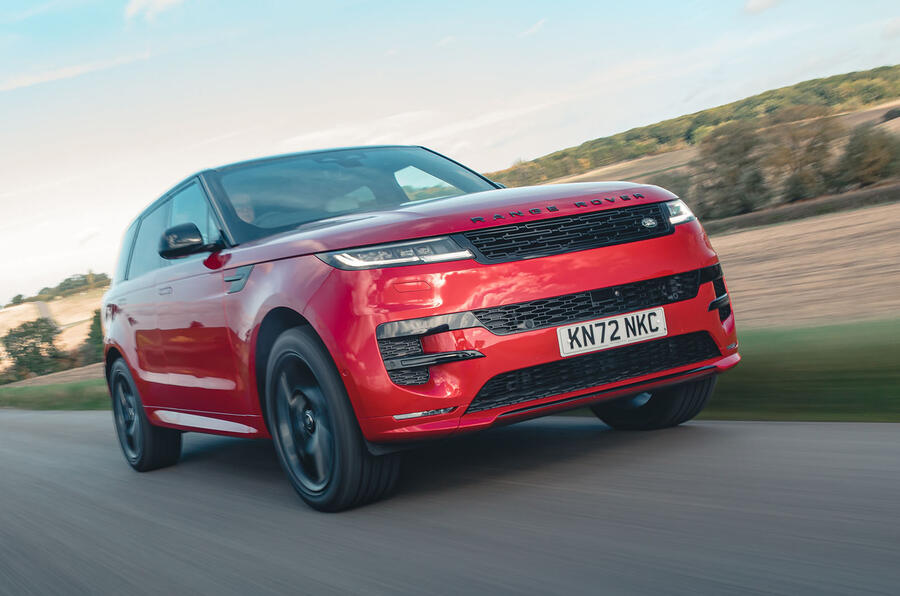
The last Range Rover wasn’t a small car, but the new one is truly gargantuan on European roads. Four-wheel steering and straight sides make it manageable, but you might just want the Range Rover experience in a slightly smaller package.
The Range Rover Sport shares much with its full-sized sibling, not least its outstanding mechanical refinement and luxury appeal. Where the Sport distinguishes itself is its capacity to control its considerable mass, to sharpen the precision of its responses and to distinguish itself as something of a driver’s car. While it is still an undemanding vehicle to drive, it is also tactile and at least a little communicative.
So if the Sport is a slightly more Europe-appropriate Range Rover, isn’t it also simply a better Range Rover? Not really, because some of the perceived quality of its interior materials doesn’t quite stack up. And when comparing with the best luxury cars, that does knock it down a few places.
Read our Range Rover Sport review
8. BMW X7
8
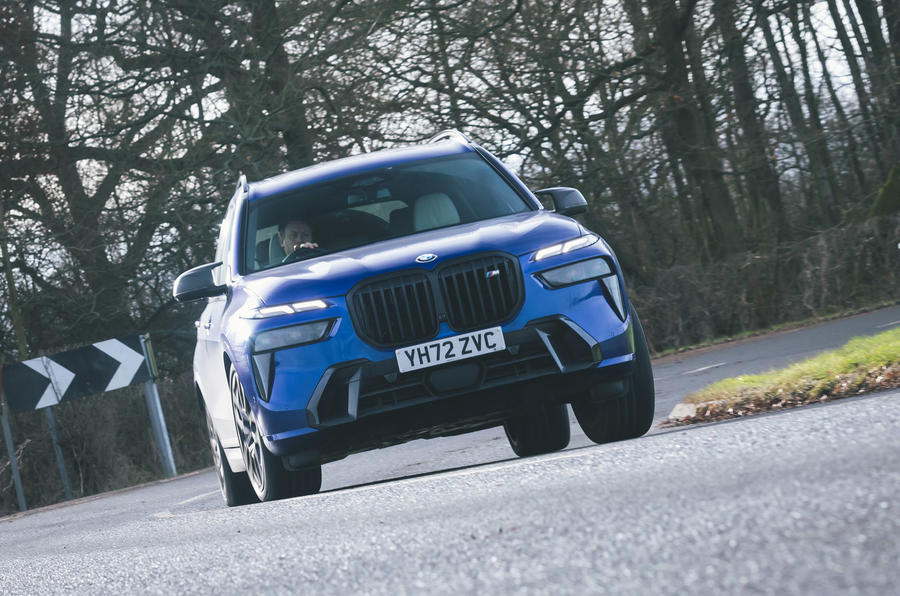
Don’t think of the X7 as an enlarged BMW X5, says the Munich-base firm, but rather a jacked-up BMW 7 Series that has been readied for limited off-roading work. That description doesn’t much account for the fact that the X7 is a seven-seat, two-box passenger car with an extended roofline, of course, but it does tell you about the priorities that BMW’s designers and engineers had when it came to refining and tuning the car, which has now been facelifted to bring in line with its lower-slung 7 Series saloon sibling
The original X7 was no shrinking violet, but it’s fair to say the latest car is even more, erm, imposing. Combining a similar twin horizontal headlight set-up and vast grille with the car’s existing barn-door frontal area means this is a car you won’t miss in your rear-view mirror. Inside, there’s a lower dashboard complete with the brand’s now familiar seamlessly curved instrument cluster and infotainment screen, while an improvement in material quality creates the air of luxury the old car just missed out on.
On the road, the X7 handles its size and bulk well, feeling surprisingly precise and athletic when cornering, while its ride is comfortable without running out of control. New for the facelift are a pair of mild-hybrid-assisted straight-six petrol and diesel engines. We’ve driven the former in smooth and eager 375bhp BMW X7 xDrive40i guise, but we suspect the torquey and efficient 347bhp xDrive40d will be the best foil to the high-riding X7. For those wanting the ultimate in conspicuous consumption, there’s always the M60i, complete with a new M-fettled 523bhp twin-turbocharged 4.4-litre V8 that helps it sprint from 0-62mph in just 4.7sec – numbers you would have needed an M5 for not too long ago.
A great many enthusiasts have taken against the modern luxury car buyer’s preference for the SUV, but when you drive a car like the Audi Q8, it’s easy to appreciate why they’re so liked. This designer take on the Audi Q7 has more visual presence and kerbside appeal than its dowdier, boxier relation but the same brilliantly rich, solid-feeling and inviting interior.
It offers generous space for four adults conveyed at a height that makes you feel like you’re lifted above the melee of traffic below and there is enough versatility and capability to deal with whatever else your daily routine is likely to throw at you, with plenty left in reserve.
Comfort and refinement are first-class. The driving experience is light-feeling and filtered, with stable and secure handling being delivered like it might be on a less advanced four-wheel-drive estate car. And the engine range is wide. You can have six-cylinder petrol or diesel power and there’s a plug-in hybrid on the way. There are also the Audi SQ8 and RS Q8 performance models, which allow you to mix as much urgency into the Q8’s driving experience as anyone could want.
SUV or not, the Q8 is undeniably one of the best luxury vehicles that Audi makes at the moment.
10. Mercedes EQS SUV
7
The EQS (number five on this list) may well sit on a completely different platform from the S-Class (number two on this list). But the EQS SUV, as you’d imagine from the slightly inelegant name, shares the same underpinnings.
That’s not such a bad thing. The steering feel is surprisingly defined and refinement is an area it scores exceptionally well in. There is virtually no road noise. Passengers will just have to put up with the tiniest trace of wind noise and, even then, that’s mostly at motorway speed. Passengers will be able to feel potholes, much in the same way that you can kind of feel the earth spinning on its axis if you really, really concentrate.
The huge shape lends itself to a vast amount of interior space. The high-set second-row seating has leg room for days, and even with the third row up, there’s a good amount of boot space.
Electric range, like in the EQS, is big thanks to gargantuan batteries. But for it to feature more prominently in this list, it would need some interior changes. The plastic air vents and gloss black centre console would be suspect in a car costing half as much.
The 10 Best Luxury Cars of 2022,The 10 Best Luxury Cars of 2022,The 10 Best Luxury Cars of 2022,The 10 Best Luxury Cars of 2022,The 10 Best Luxury Cars of 2022,The 10 Best Luxury Cars of 2022,The 10 Best Luxury Cars of 2022,The 10 Best Luxury Cars of 2022,The 10 Best Luxury Cars of 2022,The 10 Best Luxury Cars of 2022,The 10 Best Luxury Cars of 2022,The 10 Best Luxury Cars of 2022,The 10 Best Luxury Cars of 2022,The 10 Best Luxury Cars of 2022,The 10 Best Luxury Cars of 2022,The 10 Best Luxury Cars of 2022,The 10 Best Luxury Cars of 2022,The 10 Best Luxury Cars of 2022,The 10 Best Luxury Cars of 2022,The 10 Best Luxury Cars of 2022,The 10 Best Luxury Cars of 2022,The 10 Best Luxury Cars of 2022,The 10 Best Luxury Cars of 2022,The 10 Best Luxury Cars of 2022,The 10 Best Luxury Cars of 2022,The 10 Best Luxury Cars of 2022,The 10 Best Luxury Cars of 2022,The 10 Best Luxury Cars of 2022,The 10 Best Luxury Cars of 2022,The 10 Best Luxury Cars of 2022,The 10 Best Luxury Cars of 2022,The 10 Best Luxury Cars of 2022,The 10 Best Luxury Cars of 2022,The 10 Best Luxury Cars of 2022,The 10 Best Luxury Cars of 2022,The 10 Best Luxury Cars of 2022,The 10 Best Luxury Cars of 2022,The 10 Best Luxury Cars of 2022,The 10 Best Luxury Cars of 2022,The 10 Best Luxury Cars of 2022,The 10 Best Luxury Cars of 2022,The 10 Best Luxury Cars of 2022,The 10 Best Luxury Cars of 2022,The 10 Best Luxury Cars of 2022,The 10 Best Luxury Cars of 2022,The 10 Best Luxury Cars of 2022,The 10 Best Luxury Cars of 2022,Explore the world of luxury vehicles, characterized by superior quality, exceptional performance, and advanced technology. Discover the top 10 luxury cars of 2022, including renowned models like the Mercedes-Benz S-Class and Tesla Model S. Understand the latest trends in the luxury car market, including the rise of electric vehicles and sustainable practices. Determine how to choose the right luxury car for your lifestyle, considering factors like comfort, performance, and future resale value.
_____________________________________________________________________________________________________________________________________________________________________
